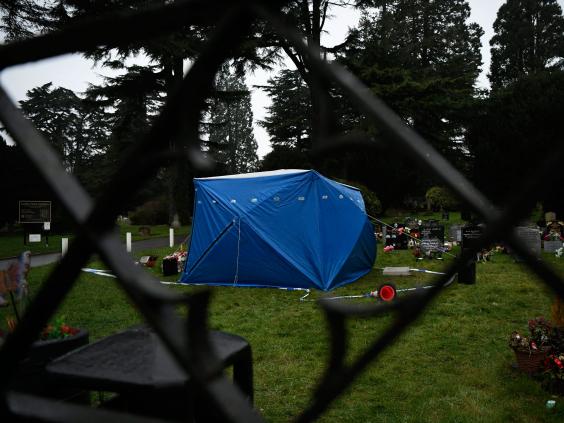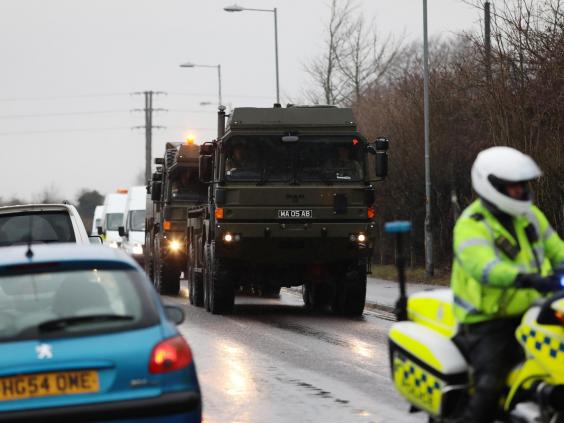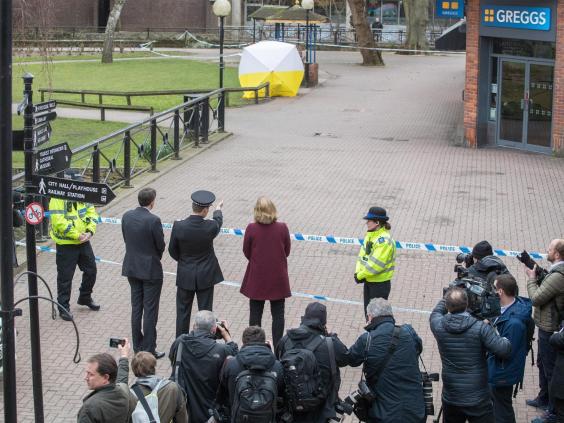
Specialist chemical and biological warfare units from the military are investigating the graves of Sergei Skripal’s wife and son after being deployed to Salisbury.
The investigation into the nerve agent attack on the former Russian double agent and his daughter Yulia intensified as up to 200 military personnel from the Army, Royal Marines and RAF moved in.
Counter-terror police, who are leading the probe, said they requested help to remove “a number of vehicles and objects from the scene in Salisbury town centre as they have the necessary capability and expertise”.
Targets included Mr Skripal’s car, an ambulance, air-ambulance helicopter and police vehicle, which were covered by people wearing protective gear and driven away on military lorries.
Officers wearing hazmat suits were seen placing a blue forensic tent over a memorial stone for the former spy’s son, Alexander, and nearby grave of his wife Liudmila.
They were both thought to have died of natural illnesses but the cause of their deaths – in 2017 and 2012 respectively – have come under renewed focus following the brazen attempt on Mr Skripal’s life.

Witnesses said investigators placed items from the graves in yellow barrels for hazardous materials, while taking others away in blue bags, potentially for further tests.
The potential lethality of the nerve agent used against the Skripals is so severe that decontamination operations are taking longer than initially expected and may go on into next week.
Those deployed include personnel from the Defence Chemical Biological Radiological and Nuclear Centre and bomb disposal experts from the 29 Ordnance Group, as well as the Falcon Squadron of the Royal Tank Regiment, who use mobile laboratories for tests and decontamination.
Specialist operations continued as Mr Skripal and his daughter remained in a “very serious” condition in intensive care, while a police officer also exposed to the nerve agent is conscious and talking from his hospital bed.
Detective Sergeant Nick Bailey was among the first officers sent to the bench where the pair were found unconscious on Sunday afternoon, and then onwards to Mr Skripal’s suburban home.
Samples from the victims have already been tested by experts at the Defence Science and Technology Laboratory at Porton Down, a secretive military facility where nerve agents have been developed and tested over decades of controversial research.
Gavin Williamson, the Defence Secretary, said Friday’s intervention built on the “vital expertise and information already provided” by military scientists.
“We have the right people with the right skills to assist with this crucial inquiry,” he added.
As the race to find out how Mr Skripal and his daughter were poisoned – and who by – the Home Secretary visited the scene where they were found on Friday morning and met DS Bailey in hospital.
“I understand people wanting to have answers [about the nerve agent and culprit], and there will be a time to have those answers”, Amber Rudd said.
“But the best way to get to them is to give the police the space they need to really go through the area carefully, to do their investigation and to make sure that they have all the support that they need.”
Ms Rudd is to chair an emergency meeting of the Government’s Cobra committee at 3pm on Saturday to receive updates on the police case, Downing Street said.
Officials have described the nerve agent used, which affected a total of 21 people, as “very rare” but investigators have not named the precise chemical used.

They are looking at the possibility that Mr Skripal was targeted at his home, where sources told The Independent a package containing the nerve agent may have been delivered and opened in the presence of his daughter.
Lord Blair, who was the Metropolitan Police Commissioner when Alexander Litvinenko was assassinated, said it was significant that DS Bailey had visited the property.
Mr Litvinenko, another former Russian spy who was an outspoken critic of Vladimir Putin, was poisoned with polonium-210 ingested via a cup of tea at a London hotel.
Lord Blair said the radioactive trail was “dangerous but pretty clear”, letting investigators trace the Russian agents who allegedly administered the substance to the plane they boarded back to Moscow.
“That was a reasonably fast activity, whereas this is going to be slower because they need, first of all, to find out how this was delivered,” he told BBC Radio 4’s Today programme.
“I’d hope [there is a trail in Salisbury] – clearly what they are trying to find out at the moment is how the nerve agent was delivered and there obviously are some indications.
“The officer, and I’m very sorry that he has been injured, has actually been to the house, whereas there was a doctor who looked after the patients in the open who hasn’t been affected at all.
“So there may be some clues floating around in here.”
Forensic tests have also been carried out at a branch of the Zizzi restaurant chain and The Mill pub in Salisbury, where witnesses say Mr Skripal began to behave in an agitated manner following lunch with his daughter.
They arrived in Salisbury for lunch at around 1.30pm on Sunday and were found unconscious on a bench at around 4.15pm – under three hours later.
A witness who saw the pair in The Mill said Mr Skripal was behaving “erratically” and shouting loudly at one point – behaviour that could be linked to the onset of his symptoms.
The pair were caught on CCTV walking down an alley near where they fell unconscious on a bench at 4.08pm on Sunday, minutes before emergency services were called.
Freya Church, a 27-year-old local resident who saw them on the bench, said: “She [Ms Skripal] was leaning on him, slumped. She looked passed out and he was looking up, doing these hand movements. His eyes were glazed.”
A passing doctor described Ms Skripal “vomiting and fitting” after losing control of her bodily functions.
The woman moved the 33-year-old into the recovery position and opened her airway, as others tended to her father.
All the symptoms are consistent with nerve agents, which vary in strength according to type, concentration and how they are administered.
Security officials say the specific chemical used would have been difficult to obtain and could only have come from a state run or state-licensed laboratory.
Chemical weapons experts told The Independent the nerve agent could have been administered in a variety of ways, including in food or drink, or in the form of a spray or liquid.
Dr Patricia Lewis, research director for International Security at Chatham House, said nerve agents act extremely rapidly if inhaled – possibly killing people within minutes – and more slowly if absorbed through the skin.
“You can impregnate them in liquid form into clothing and fabrics,” she told The Independent.
“It looks like they were both exposed at exactly the same time, otherwise one of them would have been more alert and able to call the emergency services.”
Suspicion has turned to the Russian government, which jailed Mr Skripal for “treason” in 2006, or former spies he betrayed while working for MI6 during his time as a colonel in the GRU military intelligence service.

Security officials say that 66-year-old Mr Skripal was no longer an active MI6 asset, but he may have become a target by attempting to “freelance” for private intelligence companies run by former spies.
Ministers have declined to say who is believed to be responsible in the wake of high-level Cobra and National Security Council meetings, but threatened further sanctions against Russia if state involvement is found.
The Russian government has vehemently denied involvement in the attack with foreign minister Sergey Lavrov saying: “We haven’t heard a single fact, we only watch reportages on TV where our colleagues [British politicians] say with pathos, with serious faces, that if this was done by Russia then the response will be such that Russia will remember forever.
“This is dishonest, this is pure propaganda, pure fanning of hysterics and hysteria.”

No comments:
Post a Comment